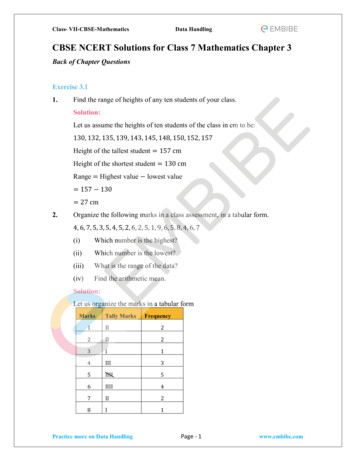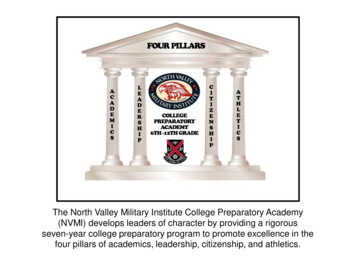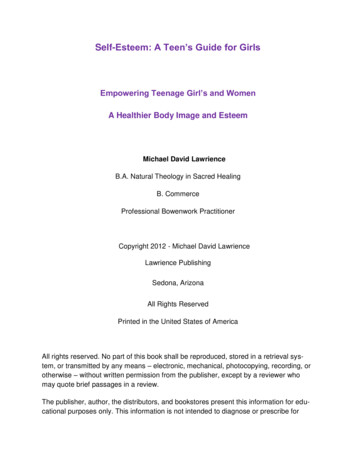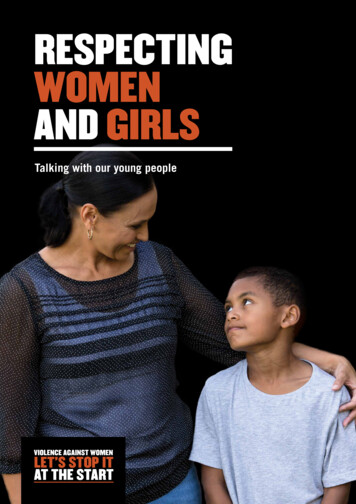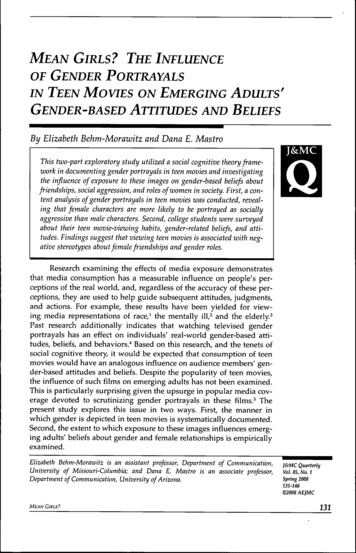
Transcription
MEAN GIRLS? THE INFLUENCEOF GENDER PORTRAYALSIN TEEN MOVIES ON EMERGING ADULTS'GENDER-BASED ATTITUDES AND BELIEFSBy Elizabeth Behm-Morawitz and Dana E. MastroThis two-part exploratory study utilized a social cognitive theory framework in documenting gender portrayals in teen movies and investigatingthe influence of exposure to these images on gender-based beließ aboutfriendships, social aggression, and roles of women in society. First, a content analysis of gender portrayals in teen movies was conducted, revealing that female characters are more likely to be portrayed as sociallyaggressive than male characters. Second, college students were surveyedabout their teen movie-viewing habits, gender-related beliefs, and attitudes. Findings suggest that viewing teen movies is associated with negative stereotypes about female friendships and gender roles.Research examining the effects of media exposure demonstratesthat media consumption has a measurable influence on people's perceptions of the real world, and, regardless of the accuracy of these perceptions, they are used to help guide subsequent attitudes, judgments,and actions. For example, these results have been yielded for viewing media representations of race,' the mentally ill, and the elderly. Past research additionally indicates that watching televised genderportrayals has an effect on individuals' real-world gender-based attitudes, beliefs, and behaviors."* Based on this research, and the tenets ofsocial cognitive theory, it would be expected that consumption of teenmovies would have an analogous influence on audience members' gender-based attitudes and beliefs. Despite the popularity of teen movies,the influence of such films on emerging adults has not been examined.This is particularly surprising given the upsurge in popular media coverage devoted to scrutinizing gender portrayals in these films. Thepresent study explores this issue in two ways. First, the manner inwhich gender is depicted in teen movies is systematically documented.Second, the extent to which exposure to these images influences emerging adults' beliefs about gender and female relationships is empiricallyexamined.Elizabeth Behm-Morawitz is an assistant professor. Department of Communication,]&MC QuarterlyUniversity of Missouri-Columbia; and Dana E. Mastro is an associate professor. Vol. 85, No. lDepartment of Communication, University of Arizona.Spring2008m-U6 2008AEIMCMEAN GIRLS?131
EffectsofMediatedGenderPortrayalsTeenQueensof theBig ScreenAccording to Bandura's social cognitive theory, media messagesserve as a meaningful source for the acquisition of "gender-linked knowledge and competencies" and the development of expectations of genderroles and conduct, self-evaluative standards, and self-efficacy beliefs.'' Itis argued that individuals adopt gender characteristics in part by monitoring the rewards and consequences associated with others' behavior.Thus, representation of female characters in the media would be expected to play a role in viewers' perceptions regarding gender identity, whichmay ultimately influence attitudes and beliefs about appropriate genderroles.The period of life referred to as emerging adulthood is a particularly unique phase of identity development, during which time media messages may serve as one source of information used to make life choices.The increased independence and freedom emerging adults experience isthought to contribute to their heightened relational and work explorations,' The lion's share of research on gender identity development,however, has focused on adolescents rather than emerging adults.Although the influence of teen movies on adolescent consumers is ofimport, the popularity of this film genre among emerging adults suggeststhat the impact of exposure on college students warrants consideration.Accordingly, the present study examines the influence of teen movies onemerging adults as the messages offered in these movies may provideexamples of gendered behavior that subsequently guide real-world judgments about gendered friendship behaviors.According to a 2005 New York Times article, "In recent years, girlshave been increasingly portrayed in everything from serious journalisticstudies to light comedies like 'Mean Girls' as tyrannical, bullying anddevoted to a ruthless caste system."' This focus on the "queen bees" offemale teenage friendships seems to dominate teen film portrayals ofgirls, when, in reality, this stereotype of the "mean girl" does not reflectthe true variety in female friendship roles and the positive attributes ofthese friendship networks,'" Moreover, although academics and the popular media have long focused on the harmful effects of teenage, femalesocial aggression," the upsurge in the popularity and production of teenmovies seems to have increased the attention to the negative features offemale friendships.For example, in 2004 the hit teen movie Mean Girls brought the portrayal of teen girls as socially aggressive to the forefront of popular discourse about female adolescence. Mean Girls was heralded by critics as"acutely hilarious sociology, nailing the servile malice of 15-year-oldgirls,"' and "not only funny but smart,"" Film critics, journalists, andtalk show hosts jumped on the bandwagon to talk about the manipulativeand mean behaviors committed by girls in female friendship circles.During this time, books such as Odd Girl Out: The Hidden Culture ofAggression in G/r/s" and Queen Bees and Wannabes: Helping Your DaughterSurvive Cliques, Gossip, Boyfriends, and Other Realities of Adolescence 132JOURNALISM & MASS COMMUNICATION QUARTERLY
received much attention. In fact. Mean Girls is loosely based on QueenBees and Wannabes.This tendency for teen movies to center on the social world ofteens likely occurs for good reason—the teenage years are typicallycharacterized by a time of relationship and identity growth and struggle,"" Moreover, it is not surprising that teen movies focus on the dominant teen girl as the "mean girl," due to the generalization that socialaggression is more prevalent among females (vs, males and physicalaggression). Although research does suggest females engage in lessphysical aggression than do males,' we cannot conclude that the stereotype of the socially aggressive girl is, in fact, accurate. Research indicatesthat this characterization may not be representative of the true nature offemale friendships. For instance, some studies suggest that socialaggression is equally common among males, and that females sometimes engage in physical aggression,' This indicates that male andfemale friendships may not be so different in terms of aggression. Evenmore important, research indicates that female friendship circles produce important positive outcomes for adolescents.Studies have demonstrated that female-to-female friendshipsmay foster more adaptive outcomes than do male-to-male friendships," Female friendships have generally been found to be moresupportive than male friendships " and are characterized by socialcooperation, ' For example, Henrich et al, studied all-male and allfemale cliques and found that female friendships were associated withnumerous positive outcomes, such as adjustment at school, peer integration, and closeness with friends, whereas male friendships were not significantly related to such outcomes, These findings suggest that femalefriendships serve an important positive role for adolescents and youngadults.In contrast to these real world indicators, it appears that teenmovies portray the social environment of the teenage girl as a contextdominated by clique members who engage in social aggression withmaladaptive outcomes. To date, however, no empirical investigationshave been conducted to systematically document the manner in whichgender and friendships are depicted in teen films. Study 1 of the present design undertakes this endeavor.Based on media reports about teen movies, it is expected that Studyfemale teen characters will be more likely than their male counterpartsto engage in acts of social aggression, and that these socially aggressiveacts will be positively rewarded with increased popularity, power,and/or feelings of pleasure. It is not expected that males and femaleswill differ significantly in terms of enacting socially cooperative behaviors. Accordingly, the following hypotheses were developed.OneHI: Female characters will be more likely to engagein social aggression than their male counterparts in teenmovies.MEAN CIRLS?233
H2: Teen characters will most often be rewarded, ratherthan punished, for their acts of social aggression in teenmovies.Method134Sample. The top 20 grossing U.S. teen movies released between 1995and 2005 were included in the current sample. Based on Internet research,approximately 90 U.S. movies released during this time period were identified as teen movies. A teen movie was deñned as a movie starringteenage characters that focused exclusively, or predominantly, on thesecharacters, and that was marketed primarily to teens and young adults.Only movies meeting these criteria, released on DVD or VHS for homepurchase, and rated G, PG, or PG-13 were considered. R-rated movieswere excluded because, at the time of this investigation, even freshmanand sophomore college students would have been too young to legallyview them during this ten-year time period.The following films were included in the analysis: A Cinderella Story(2004), A Walk to Remember (2002), Blue Crush (2002), Bring It On (1999),Clueless (1995), Confessions of a Teenage Drama Queen (2004), Crossroads(2002), Drumline (2002), Freaky Friday (2003), Mean Girls (2004), NapoleonDynamite (2004), Orange County (2002), Princess Diaries (2001), Romeo Juliet (1996), Save the Last Dance (2001), She's All That (1999), 10 Things IHate About You (1999), The Lizzie McGuire Movie (2003), What a Girl Wants(2003), and You Got Served (2004).Coder Training. Three undergraduate students served as coders inthe examination of these films. They were trained for approximatelyforty-four hours on teen movies outside the actual sample. Reliabilitiesreported below were calculated with an overlapping subset of the actualsample (10%, n 2) using Krippendorff's alpha.Units of Analyses. Variables were designed to reflect the behaviorsand characteristics associated with social cooperation and social aggression, as identified by psychology research. Judgments were made at thecharacter level.Characteristics. Coders assessed a variety of demographic variablesfor teen characters in each movie. First, the gender (a 1.0) of each character was coded as male or female. Second, the role of each character wasidentified (a 1.0). Only primary and secondary characters were coded.Primary characters were defined as any character in the story whose presence was crucial to the plot. Secondary characters were defined as characters that added depth/interest to the plot but were not crucial to its existence. Next, the race (a 1.0) of each character was assessed as White(non-Hispanic), Hispanic, Asian American/Pacific Islander, AfricanAmerican or Black, Native American, or Other. Finally, the age (a 1.0) ofthe character was assessed using Stern's age categories. The followingthree categories were used: 19-20 years of age (post high school/in college), 15-18 years of age (high school), and 12-14 years of age (juniorhigh/middle school).Socially Cooperative Behavior. Coders recorded how many times eachprimary and secondary character intentionally enacted a socially cooperaJOURNALISM & MASS COMMUNICATIOM QUARTERLY
tive behavior, which was defined as the use of cooperative and inclusivebehaviors that fostered a supportive environment and adaptive outcomes. These behaviors involved making peers feel included, emotionally supported, and secure. Coders were provided with five subcategories of cooperative behaviors, which were later combined to form thevariable social cooperation. The following five categories were chosenbased on the psychology-based literature related to social cooperationand teenagers: '' providing support {a .75), including others (a 1.0),teamwork (a .78), sharing {a .72), and resolving conflict (a .88)Socially Aggressive Behavior Coders also recorded how many timeseach primary and secondary character intentionally enacted the following socially aggressive behaviors during the course of the film.Socially aggressive behavior was defined as the use of "indirect" aggression to damage another's status or self-esteem such as bullying tactics,spreading rumors, silent treatment, note-passing, backstabbing, publicor private humiliation, and other malicious acts. It does not includephysical aggression. The following four subcategories, derived fromexisting literature, were combined to form the variable: gossiping (a .86), backstabbing (a .78), humiliating others {a .88), and excludingothers (a .77).Consequences. In addition to recording the above relational behaviors, coders assessed the outcomes of these behaviors. They were instructed to code any explicit consequence for any socially cooperativeand socially aggressive behaviors enacted by teenage primary and secondary characters. To be considered an explicit consequence, the outcome must have been demonstrated in the movie. To avoid complication, only short-term consequences (i.e., within twenty-four hours of theact) were recorded. Positive consequences (a .72) were defined as areward, benefit received, a gain, or something positive that follows abehavior. Negative consequences (a .76) were defined as a punishment, a loss, suffering, or something negative that follows a behavior.Among the 20 movies in the sample, 139 characters were identified. The gender breakdown of the characters consisted of 54.7%(n 76) female and 45.3% (n 63) male characters. White/Caucasiancharacters were the most prevalent at 73.4% (« 102). AfricanAmerican/black characters constituted 20% (n 28) of the character set;3.8% {n 5) were Latino; 0.8% (n 1) were Asian; and 2.2% (n 3) wereidentified as other. Among the age ranges included in the study, themajority of characters were identified as being 15-18 years old/highschool students (n 121, 87%), followed by 19-20 year olds/college students (n 17,12.2%) and 12-14 year olds/middle school students (n 1,0.8%). In terms of movie rating, 60% were rated PG-13 (n 12), 40%were rated PG (n 8), and none were rated G.Socially Aggressive Behaviors. Overall, 337 incidents of sociallyaggressive behavior were coded. Independent sample t-tests were conducted to determine whether or not gender differences existed in theenactment of the relational behaviors of interest. Results indicated thatMEAN GIRLS?Results135
male and female characters differed in terms of enacting socially aggressive behaviors, f -3.15, p .05. Female characters (M 3.08, sd 3.13)were significantly more likely to engage in socially aggressive behaviorsthan males (M 1.63, sd 2.03).Socially Cooperative Behaviors. Overall, 534 instances of sociallycooperative behaviors were coded. As a whole, there were no significantgender differences in the rate of these behaviors, t 0.05, p .05.Consequences. The positive and negative consequences associatedwith the enactment of socially aggressive behaviors and socially cooperative behaviors were coded to gain an understanding of how male andfemale characters were rewarded or punished for socially positive andnegative behaviors. Results indicated that there were no gender differences in the rewarding of socially cooperative behaviors, t 0.27, p .05.Additionally, there were no gender differences in the negative consequences associated with socially cooperative acts, t 0.78, p .05. However, there were gender differences in rewarding socially aggressivebehaviors, t -2.29, p .05, such that females (M 0.70, sd .46) were significantly more likely to be rewarded for socially aggressive behaviorsthan were their male counterparts (M 0.53, sd .50). Finally, there wereno significant gender differences in the punishment of socially aggressivebehaviors, f 0.77, p .05. Moreover, means reveal that both male andfemale characters were more often rewarded than punished for sociallyaggressive acts. Male characters were rewarded (M .53, sd .50) moreoften than punished (M .25, sd .43). Similarly, socially aggressive actscommitted by females were more often rewarded (M 0.70, sd .46) thanpunished (M .19, sd .39).UtSCUSSton136 g hypothesized, results indicate that female characters are significantly more likely to engage in and be rewarded for socially aggressivebehaviors than are male characters in teen movies. This thematic portrayal of female teenagers indicates that teen films have a tendency to rely onthe stereotype of teen girls as "mean girls." Further, results reveal tbatboth males and females were more often rewarded than punished forengaging in social aggression with females significantly more likely to berewarded tban males. This suggests that teen movies portray sociallyaggressive acts as rewarding, particularly for females.From the perspective of social cognitive theory, it would be expected tbat exposure to such messages among the appropriate audience couldpotentially result in the development of unfavorable beliefs about femalefriendships and negative attitudes toward women in general. Moreover,viewing the rewards associated with the socially aggressive behaviorsdepicted in these movies may send the message that actions of this natureare an effective means to gaining status and other positive rewards. Itshould be noted, however, that socially cooperative behaviors outnumbered socially aggressive behaviors in the films on the whole. Thus, it ispossible that the presence of socially cooperative behaviors in teen filmsmay lessen the negative effects resulting from exposure to the modelingof social aggression.¡ouRNAUSM & MASS COMMUNICATION QUARTERLY
One limitation of this content analysis that should be considered,however, is the coding of only short-term behavioral consequences inthe movies. Due to the complicated nature of accurately identifying andmatching long-term consequences with specific socially aggressive andsocially cooperative behaviors performed earlier in the movie, codersonly identified short-term consequences. This does not provide us witha picture of how social aggression and social cooperation are ultimatelyrewarded or punished at the conclusions of the movies. Future researchshould attempt to account for such overarching messages and themesabout friendship behaviors represented in teen movies that cannot becaptured in short-term behavioral consequences alone. On the otherhand, many of these short-term occurrences of social aggression andsocial cooperation comprise significant plot elements of the films andare likely not easily forgotten. So, although it is possible that socialaggression is punished at the end of some of these films in the communication of a broader moral message, the instances throughout the filmswhere these acts are rewarded are significant and likely very memorable to audiences.Study 2 investigated the extent to which individuals' gender-related beliefs and attitudes were influenced by exposure to these teen films.The assumptions of social cognitive theory were again applied to explicate this process. Social cognitive theory suggests that a number of factors influence the outcomes of exposure to media-modeled, genderedbehaviors. Repetition of the message, liking and identification with themedia models, and motivation are all factors that influence the adoption of such behaviors, ** This would suggest that emerging adults whoreport watching multiple teen movies, and, perhaps, watching some ofthese films numerous times, will be more likely to retain the sociallyaggressive behaviors represented in these movies for later use whencontextually relevant. Additionally, social cognitive theory would suggest that the more the consumers identify with the movies and characters, the more likely they are to adopt the gendered attitudes, beliefs,and behaviors portrayed in these movies, 'In the present case, it seems reasonable that a viewer's feelingsof similarity (i,e,, homophily) to the characters and teen movie stories,and wishful identification (or desire to be like/act like) " with teenmovie characters will work together to create a feeling of affinity withthese characters. Consistent with social cognitive theory, greater affinity with the media models would increase the likelihood that individuals attend to, remember, and apply the observed behaviors in their ownlives.Together, these assumptions suggest that both amount of exposure to teen movies and affinity with teen movie characters will influence the acquisition of gendered beliefs, perceptions of female friendships, evaluations of friends' behaviors, and perceptions regarding rolesof women in society. In order to test these theoretically derived relationships, the following predictions were formulated:MEAN GIRLS?StudyTwo137
Hl: As levels of teen movie viewing increase, higherlevels of affinity with teen movies and characters will beassociated with increasingly negative attitudes toward femalefriendships and women in general.Further, social cognitive theory suggests that liking is an important factor in observational learning, such that the more an individuallikes the media models, the more likely he/she is to adopt the modeledbehaviors. ' Therefore, it is possible that the more individuals report liking teen movies, the more likely they are to report attitudes and beliefsconsistent with the behaviors modeled in these movies. As such, an interaction effect between exposure and liking is predicted.H2: Teen movie exposure and liking teen movies willinteract in predictions regarding gender-based attitudes andbeliefs about female friendships and women in society.Finally, research suggests that the sex of the participant is likely toinfluence knowledge acquired from viewing the movies. Studies suggestthat individuals may identify with media characters based on gender,thus influencing one's attention, retention, and production of observedbehaviors. As a result, it is predicted that an interaction effect betweenexposure to teen movies and sex is likely to occur.H3: Exposure to teen movies and sex will interact inpredicting gender-based attitudes and beliefs about femalefriendships and women in society.Participants. The important development stage of emerging adulthood combined with the fact that college-age students represent a significant portion of the target market for teen movies makes undergraduatestudents an appropriate sample for this study. One hundred thirty-fiveundergraduate students in an introductory communication course at alarge southwestern university participated in the study. Sixty-four percent of the participants were female (w 87) and 36% were male (n 48).The average age of the participants was between 19 and 20 years old.Sixty-eight percent of the participants were white (w 92), 22% wereLatino (n 29), 4% were African American (M 6), 3% were Asian (n 4), 1%were Native Hawaiian or Pacific Islander (M 1), and 2% reported theirrace/ethnicity as "Other" {n—3).Independent Variables. Factor analysis was conducted in the construction of all scaled constructs, with Cronbach's alpha reported below.Items were assessed using principal-axis factoring and with a varimaxrotation. Only items that achieved a factor loading of 0.50 or higher wereretained.Exposure. Exposure to teen movies was measured by asking participants to look at a list of teen movies and indicate how many of themovies they had seen, owned on DVD or VHS, and / or had seen more138JOURNALISM & MASS COMMUNICATION QUARTERLY
than once. These responses to these three items were summed to createone overall measure of exposure to teen movies.Ajfinity (a .90, M 2.69, sd 0.79). Affinity with the moviesand characters was measured by asking participants to respond toseven statements, such as "I can relate to teen movies," "I would wantto be friends with the characters in teen movies," and "Characters inteen movies are similar to people I know." Responses were measuredusing a 5-point scale, ranging from "strongly disagree" (1) to "stronglyagree" (5).Liking (r .57, M 3.45, sd 0.93). In order to assess liking of teenmovies, participants were asked to respond to two statements: "I liketeen movies" and "I do not enjoy watching teen movies." The itemswere measured using a 5-point scale from "strongly disagree" (1) to"strongly agree" (5). Negatively worded statements were reverse coded.Dependent Variables. Dependent variables included the following gender-related attitudes and beliefs pertaining to friendships androles of women in society.Female Friendships (a .91, M 2.53, sd 1.06). Participantsresponded to four statements about their own beliefs about howfemales act with their female friends, such as "Females are very supportive with their female friends," "Females are often catty to oneanother," and "Females are often manipulative in their friendships."These items were measured on a 5-point scale, ranging from "stronglydisagree" (1), indicating negative beliefs about female friendships, to"strongly agree" (5), indicating favorable beliefs about female friendships.Male Friendships (a .69, M 2.52, sd 0.78). Participantsresponded to three statements about their own beliefs about how malesact with their male friends, such as "Males are often manipulative intheir friendships," "Males are very supportive with their malefriends," and "Males often act in ways that are mean to other males."These items were measured on a 5-point scale, ranging from "stronglydisagree" (1) to "strongly agree" (5).Negative Evaluations of Friends' Behaviors {r .63, M 2.98, sd .94).The following two items were used to assess participants' perceptions regarding the mean-spiritedness of their friends' behaviors:"My friends can often be mean to each another," and "My friends canoften be mean to other people." The statements were scored on a5-point scale, ranging from "strongly disagree" (1) to "strongly agree"(5).Positive Evaluations of Friends' Behaviors (a .70, M 3.85, sd 2.31). Four items were used to construct a measure of respondents'perceptions of their friends' positive or prosocial friendship behaviors. Statements included "My friends are very supportive of me"and "My friends treat each other with kindness." These items wererated on a 5-point scale ranging from "strongly disagree" (1) to "strongly agree" (5).Consequence of Social Aggression. Participants were asked to re-spond to the following single item measuring beliefs about the relationMEAN GIRLS?139
ship between social aggression and popularity: "Being mean to peers oflesser status can make a person more popular." Response options rangedfrom "strongly disagree" (1) to "strongly agree" (5).Attitudes toward Women (a .84, M 2.00, sd 1.10). Participantswere asked to fill out a modified version of the attitudes toward womenscale'' in order to assess the impact of exposure to teen movies on viewsregarding women. This twelve-item scale, which includes statementsabout male and female roles, attributes, and rights, consisted of nine itemsfrom the original attitudes toward women scale and three new items. Thenew items asked participants to respond to statements about female rolesand relationships in the workplace such as "Men make better bosses thanwomen." Response options ranged from "strongly disagree" (1) to"strongly agree" (5), where higher scores indicate less favorable attitudestoward women.HI. Multiple regression results, all controlling for the participant'sage, level of television consumption, and movie preferences (e.g.,liking/enjoyment of particular movie genres), provide partial support forHI. As postulated, a significant character affinity by movie exposure interaction was revealed on evaluations of friends' cruelty, AF 4.26, AJR .03,df 128, p .05, such that as affinity increased, unfavorable evaluationsof friends' behavior were increasingly associated with higher rates ofviewing teen movies (ß -.17, t -2.06). In other words, the more emerging adults identified with teen movies and characters and the greater theexposure to teen movies, the more likely they were to report negativeperceptions of their friends' friendship behaviors. No significant effectwas found for character affinity by movie exposure for participants' positive evaluations of their friends' behaviors, Af 0.06, AR .00, df 129,p .81. Neither character affinity (ß -.11, p .26) nor movie exposure iß -.02, p .81) had any effect on respondents' evaluation of theirfriends' positive friendship behaviors.Partial support was additionally provided for HI based on examinations of attitudes regarding (a) female friendships, (b) the role of womenin society, and (c) the belief that popularity is a reward for social aggression. Although interaction effects were not revealed, significant and negative direct effects for both exposure to teen movies (ß -.51, t -6.23) andaffinity with characters in teen movies {ß -.20, í -2.62) were emergentfor attitudes regarding female friendships, AF 26.74, AR .25, df 128,p .01, indicating that increases in viewing teen movies as well as greateraffinity with the characters in teen movies each were associated with moreunfavorable evaluations of females' interactions in their friendships.Similarly, significant direct effects of teen movie viewing and affinity withcharacters in teen movies were found for attitudes regarding the role ofwomen in society, AF 4.90, AR .07, df 127, p .01. Here, increasedexposure (ß -.22, t -2.18) was associated with less favorable attitudestoward women's rights, whereas increas
inant teen girl as the "mean girl," due to the generalization that social aggression is more prevalent among females (vs, males and physical aggression). Although research does suggest females engage in less physical aggression than do males,' we cannot conclude that the stereo-type of the sociall
